Fantasia 2019, Day 11, Part 4: Things That Go Bump in the East
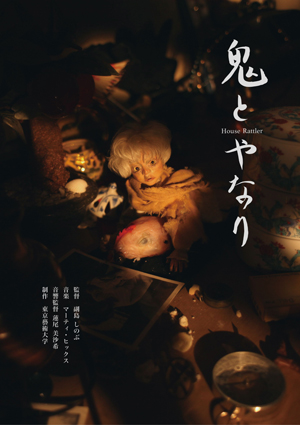 My last screening of July 21 brought me back to the De Sève Theatre for a showcase of animated short genre films from China, Taiwan, Korea, and Japan, a grouping titled “Things That Go Bump In the East.” 11 films in a range of visual styles promised variety. I’d been having good luck with short films at the festival so far, and settled in eager to see what would come now.
My last screening of July 21 brought me back to the De Sève Theatre for a showcase of animated short genre films from China, Taiwan, Korea, and Japan, a grouping titled “Things That Go Bump In the East.” 11 films in a range of visual styles promised variety. I’d been having good luck with short films at the festival so far, and settled in eager to see what would come now.
First was a 6-minute stop-motion story from Japan’s Shinobu Soejima, “The House Rattler” (“鬼とやなり”). It’s based on Japanese folklore, telling a tale of a spirit who makes the mysterious sounds with no obvious source that you sometimes hear in an old house. In this case, the little demon comes into conflict with the modern world in a surprising fashion. The film makes strong use of sound cues, as you might expect, and the setting of the house haunted by the tiny dweller-in-wainscots is a wondrous mix of shadows and rich gold-brown hues. It has the feel of age and of a place lived-in, and that helps bring out the modern twist at the end.
Next was “The Girl and the Serpent,” directed and written by Wan Jinyue and Du Jinzhi. It’s also 6 minutes long, but has a much faster pace than the atmospheric “The House Rattler.” A snake-demon demands a village produce a maiden sacrifice, but ends up with an unexpected fight. The story’s a striking mix of 2D and 3D animation, with colour being used as a major element in the storytelling. The imagery’s fluid, shifting swiftly as the demon works against the girl both physically and psychically. Nevertheless, she finds the strength to resist. It’s a stunningly designed battle, and an entertaining short.
“Rainy Season” (“장마”), by writer-director Kim Se-yoon, brought a noirish horror-inflected feel to seemingly hand-drawn animation. It’s an intensely atmospheric 4-minute piece about a woman in an apartment during a storm. She’s shooting up, but is interrupted by a flash of lightning and something eerie in the tall building across from her. Alone in her apartment, she grows increasingly paranoid — but then, just because you’re paranoid doesn’t mean something isn’t out to get you. It’s a well-done piece of suspense.
The 17-minute “Gold Fish” (“Kim-hi,” 金魚), written and directed by Taiwan’s Fish Wang, is the story of a boy in a weird dystopia, slightly steampunk and more than slightly supernatural. The inhuman masters of a a sprawling, bleak city are drinking the dreams of children. Elderly adults are all but immobile, enslaved to inhuman masters. Except one boy has a chance to fight back, and topple the whole of the corrupt society. It’s an expressionistic story with some deliberately crude designs and some excellent colour work. Cool, dark tones contrast strongly with unexpected moments of eye-popping colour. It’s not a complex story, but the scenes that illustrate the different movements of the tale are very well-done, and the tale builds nicely through a series of increasingly surreal images. I felt the ending lacked a little, but it was on the whole a solid and surprising short.
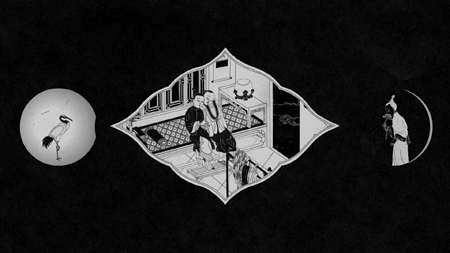 The next movie was “The Six,” a five-minute tale written by Chen Xi and directed by Chen with An Xu. It’s a fascinating movie with an intricate structure. Against a black background three images appear; to left and right are moonlike discs, in the centre a lozenge-shaped field displaying a house with a man and woman. The background’s black as night, while the three images display white-and-black line art. Each of these images are really fields in which other images appear, and which interact in surprising ways each with the others. Collectively they tell a fascinating mythic tale of cunning, foolishness, and (as I understand it) infidelity. It’s quite brilliant, and the fluid lines are lovely, but what is crucial is that the unconventional storytelling style works.
The next movie was “The Six,” a five-minute tale written by Chen Xi and directed by Chen with An Xu. It’s a fascinating movie with an intricate structure. Against a black background three images appear; to left and right are moonlike discs, in the centre a lozenge-shaped field displaying a house with a man and woman. The background’s black as night, while the three images display white-and-black line art. Each of these images are really fields in which other images appear, and which interact in surprising ways each with the others. Collectively they tell a fascinating mythic tale of cunning, foolishness, and (as I understand it) infidelity. It’s quite brilliant, and the fluid lines are lovely, but what is crucial is that the unconventional storytelling style works.
Next came the 3-minute “Tempura,” written and directed by Ujicha, the animator behind 2018’s Violence Voyager. I respected the work that went into that feature, while not being engaged by the animation style of moving still images over and against each other, and ultimately not caring for the wise-ass tone of the thing. That statement applies to “Tempura,” in which two boys enter a mysterious cave in search of their missing friend; they find him, but nasty things happen to the three of them. I can’t say anything bad about the craft in this short, but the appeal is either completely over or completely under my head.
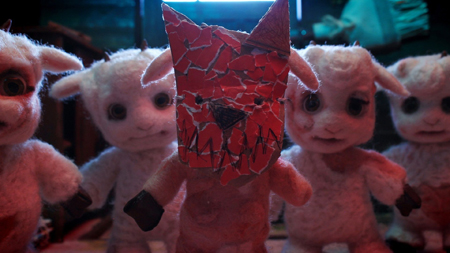 Then came “My Little Goat” (“マイリトルゴート “), a 10-minute stop-motion short by Tomoki Misato (I could not find a writing credit for the film). A mother goat rescues her brood from the belly of a wolf, cutting him open to retrieve the partially-digested kids. But she’s missing one. She finds him — or thinks she has. And then weirder things happen. It’s a story that shouldn’t work, and which most of the way through I thought was a misfire. But the ending provides the retrospective key to the whole thing. It’s an interesting approach, saying something about parental love versus parental betrayal. I was mostly convinced, although I think there’s an argument to be made that the film’s narrative approach isn’t quite up to the emotional terrain of its subject matter — not because of the darkness involved, but because it might not have enough complexity in the character of its lead. I don’t particularly hold this to be true, in part because the childlike stop-motion plays to the darkness in some complex ways. But I can’t dismiss the idea entirely. Still: this is a story with an intriguing structural approach, and a well-animated film with some disturbing and bizarre imagery.
Then came “My Little Goat” (“マイリトルゴート “), a 10-minute stop-motion short by Tomoki Misato (I could not find a writing credit for the film). A mother goat rescues her brood from the belly of a wolf, cutting him open to retrieve the partially-digested kids. But she’s missing one. She finds him — or thinks she has. And then weirder things happen. It’s a story that shouldn’t work, and which most of the way through I thought was a misfire. But the ending provides the retrospective key to the whole thing. It’s an interesting approach, saying something about parental love versus parental betrayal. I was mostly convinced, although I think there’s an argument to be made that the film’s narrative approach isn’t quite up to the emotional terrain of its subject matter — not because of the darkness involved, but because it might not have enough complexity in the character of its lead. I don’t particularly hold this to be true, in part because the childlike stop-motion plays to the darkness in some complex ways. But I can’t dismiss the idea entirely. Still: this is a story with an intriguing structural approach, and a well-animated film with some disturbing and bizarre imagery.
“Another” (“어나더”) was an 8-minute story written and directed by Park Yeon. It’s a (seemingly) hand-drawn story about a boy who meets the ghost of his dead twin. The ghost has been watching him for years. But the world is literally only big enough for one of them. It’s a charming, funny story that plays a little like Calvin & Hobbes meets The Twilight Zone — the first for its visual style and knowing sense of childhood, the second for its sardonic humour and well-crafted spookiness that ends with a twist.
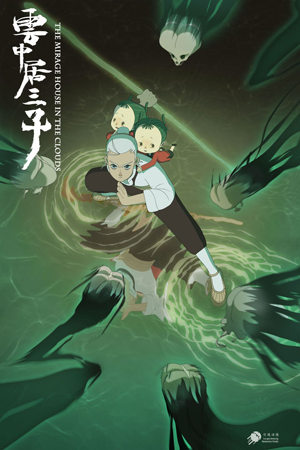 Cao Runze directed “Spirit of the Drowning Girls” (“云中居三子 溺女婆篇”) from a script he wrote with Jin Zewei. It’s a well-animated wuxia story of a magical battle between a wanderer and a powerful witch; the traveller just wants to return two little girls to their home, but things are not what they seem. There’s a darkness here that rises to the surface as the film goes on, in terms of the historical material it deals with, but the animation is fluid and the designs eye-catching. If I wonder about whether the form of “My Little Goat” fit the seriousness of the themes it was dealing with, I have to wonder the same thing here; but I would say this movie’s telling an adventure story that theoretically can work independently of the thematic content. Certainly as as adventure it succeeds, and I thought the darker material gave the action a bit of punch. Other people may find it trivialises something tragic, and I wouldn’t really be able to argue.
Cao Runze directed “Spirit of the Drowning Girls” (“云中居三子 溺女婆篇”) from a script he wrote with Jin Zewei. It’s a well-animated wuxia story of a magical battle between a wanderer and a powerful witch; the traveller just wants to return two little girls to their home, but things are not what they seem. There’s a darkness here that rises to the surface as the film goes on, in terms of the historical material it deals with, but the animation is fluid and the designs eye-catching. If I wonder about whether the form of “My Little Goat” fit the seriousness of the themes it was dealing with, I have to wonder the same thing here; but I would say this movie’s telling an adventure story that theoretically can work independently of the thematic content. Certainly as as adventure it succeeds, and I thought the darker material gave the action a bit of punch. Other people may find it trivialises something tragic, and I wouldn’t really be able to argue.
Jeon Jinkyu’s “The Death Vendor” (“Juk-eum-ui Sang-in,” “죽음의 상인”) came next, a strange 6-minute work of line animation about a man selling schoolboys bird chicks from a box. It’s a disturbing if (to me) elliptical story, about death and choices. I think in particular it’s about becoming aware of one’s own mortality and one’s link to the rest of the world. It’s lovely work, with a haunting cello soundtrack to match the metamorphosing imagery.
The final film was “Shishigari” (“シシガリ”), written and directed by Kiyotaka Oshiyama. In a snow-locked land, a youth (voiced by Megumi Han) among a tribal people sets out on a hunting trip that will be his rite of passage. It will be more severe than he knows. This is a beautiful, stern film that closely follows the youth’s travails and journey in a forbidding terrain, and yet is of more than merely anthropological interest. The designs are lovely and real, and the story balances the youth’s struggles against nature, the quiet moments between strife, and the hunting of a deadly beast. And there is also the image of the father or mentor, adding a subtext to all the youth’s adventures.
If I seem to have had almost entirely good things to say about the movies of this showcase, it’s because as a whole it was spectacular. The animation styles were well-chosen, but more than that, on the whole they also demonstrated the power of the medium. The way colour built a world along with a specific tone; the way the stop-motion stories made characters out of objects; the way the drawn images shifted easily from one thing into another thing, metamorphosing with a naturalness even computers can’t really give to physical objects. These stories were excellent brief genre tales that collectively impressed me with their distinct approaches.
A brief question-and-answer period followed with five of the directors, enough participants to seriously challenge my ability to keep up with my handwritten note-taking. A questioner who had noted Tokyo University of the Arts in the credits of some of the films asked if these were graduate projects; Rupert Bottenberg, the director of Fantasia’s animation section Axis, said a number of the shorts came from there, but not all. I was able to record the directors’ answers to a question about what the inspiration was behind their films:
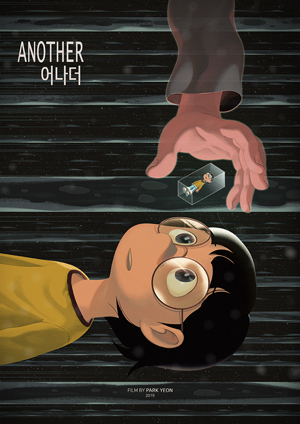 Kiyotaka Oshiyama of “Shishigari” spoke about the reality behind the cultural tradition he depicted, and a people (I believe he mentioned the Matagi people of Tohoku), who had a particular relationship with nature; they hunt their food, but appreciate nature for providing its bounty. Cao Runze of “Spirit of the Drowning Girls” said that his film was a commercial short for a TV series, based on a story from ancient Chinese literature when parents drowned girls to avoid paying a heavy tax; while laws were soon passed forbidding the practice, it nevertheless continued for some time.
Kiyotaka Oshiyama of “Shishigari” spoke about the reality behind the cultural tradition he depicted, and a people (I believe he mentioned the Matagi people of Tohoku), who had a particular relationship with nature; they hunt their food, but appreciate nature for providing its bounty. Cao Runze of “Spirit of the Drowning Girls” said that his film was a commercial short for a TV series, based on a story from ancient Chinese literature when parents drowned girls to avoid paying a heavy tax; while laws were soon passed forbidding the practice, it nevertheless continued for some time.
Jeon Jinkyu of “The Death Vendor” said that when he was young he actually saw someone selling chicks outside a school, and noted this was not uncommon in Korea. The children knew the birds would only live a week, but still bought them. To him, the man was selling death to the kids. He bought one himself to try to save it, but it died anyway; in time he came to learn that there are things one cannot save with one’s own hands.
Park Yeon of “Another” said his movie was inspired by the competitive Korean environment for kids, with private academies and lots of homework. He wanted to do a thriller, and the image of the twins in The Shining stuck with him. The message of the film, he observed, was that the grass was always greener on the other side. Finally, Kim Se-yoon of “Rainy Season” said he’d had to watch a lot of graduate projects, and found them boring; he wanted to do something unforgettable. He noted the movie was inspired by real events, but reassured us that he didn’t do drugs.
That was my last film of the day. My schedule would be lighter over the next little while, but I’d still be back at Fantasia the next day, once again for something completely different than anything I’d seen so far.
Find the rest of my Fantasia coverage from this and previous years here!
Matthew David Surridge is the author of “The Word of Azrael,” from Black Gate 14. You can buy collections of his essays on fantasy novels here and here. His Patreon, hosting a short fiction project based around the lore within a Victorian Book of Days, is here. You can find him on Facebook, or follow his Twitter account, Fell_Gard.
“The inhuman masters of a a sprawling, bleak city are drinking the dreams of children. Elderly adults are all but immobile, enslaved to inhuman masters.” (Gold Fish)
Now I’m going to have to re-watch it, if I can find it. It was my understanding that the children (and, presumably, young adults who weren’t the enforcers) were “enslaved” by the older generation that hired the strangely-clad goons who went about the business of stealing the dreams — primarily for the local autocratic, but also for the wheel-chair bound elders who refused to die.
I felt it was a film about inter-generational struggle. Not necessarily that we as a society should kill off the elderly, but more symbolic in the sense that the gerontocracy had gone too far and gone on too long. (This message being of particular poignance for non-Canadians, what with that young fellow in the Prime Minister’s chair.)
You may well be right. My grasp of that movie was a bit hazy. I thought the dreams were specifically for the non-humans, and that the older humans were acting as puppets. But I would not swear to this at all. Intergenerational conflict makes a lot of sense to me as theme, either way.